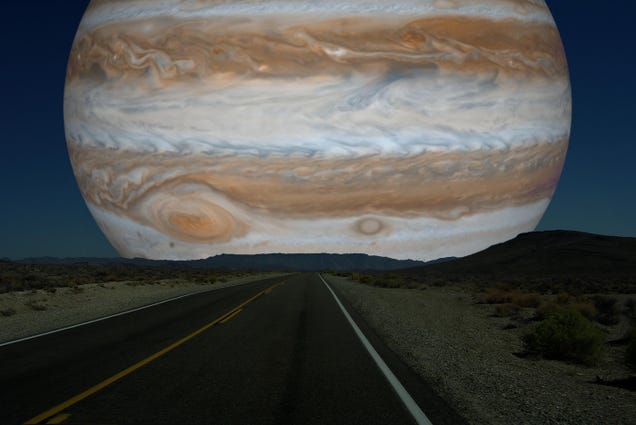Astronomy and planetary facts and fun:
Ron Miller, photographer, illustrator and former art director for the National Air and Space Museum's Albert Einstein Planetarium created a series of images visualizing what our nightly views might look like if planets, instead of our moon, orbited Earth. Here are some gems, but please visit his website at: http://io9.com/5929076/what-if-we-had-a-planet-instead-of-a-moon
FACTS:
- Our moon is pretty big - it is a quarter the diameter of the Earth.
- At a distance of about 240,000 miles, the Moon occupies a space int he night sky about half a degree wide. By Sheer coincidence, this is close to the same size the sun appears (which is why we occasionally get total solar eclipses).
- Mars, the red planet, is almost exactly twice the size of the moon - so it would appear twice as big in the Earth's sky.
- Venus is three and a half times larger than the moon.
- Neptune and Uranus are more than fourteen times larger than the moon.
- Saturn is almost 35 times larger than the Moon.
- Jupiter is the largest planet, forty ties larger than the Moon.
Here is what it would look like if Mars orbited Earth.:

Here is what it might look like if Venus orbited Earth. Miller notes that Venus "would be nearly as large in our sky as the Earth appeared to the Apollo astronauts, when they were walking on the surface of the Moon."

Here is what it might look like if Neptune orbited Earth. Miller notes, "Neptune would loom like an enormous blue balloon in the night sky. And dominate the daytime sky, as well. All other things being equal, an eclipse of the sun would seem to last forever."

Here is what it might look like if Uranus orbited Earth. Miller notes that Uranus is nearly the same size as Neptune and would provide a very similar view:

Here is what it might look like if Saturn orbited Earth. Miller notes that Saturn's "golden globe would cover nearly 18 degrees of the sky...the rings would stretch nearly from horizon to horizon.":

Here is what it might look like if Jupiter orbited Earth. According to Miller, "Jupiter would stretch 20 degrees across the sky...This close, we'd be looking "up" at the northern hemisphere and "down" at the southern hemisphere, so the cloud bands would be distinctly curved in perspective....We would not be able to visualize the north and south poles of the planet.":

Mixing Math, Science and Science Fiction:
The infographic below (How Many Alien Civilizations are there in the Galaxy?)was designed by Information is Beautiful to illustrate the Drake equation for the BBC. The Drake equation is a probabilistic equation used to calculate how many potential aliens may exist in the Milky Way Galaxy. Here is a link for the really curious souls among us: http://activemind.com/Mysterious/Topics/SETI/drake_equation.html Also note that this is an interactive equation - it changes with different input. For REALLY BOLD explorers,you can use this same link (scrolling down) to see how it changes.
The Drake equation was written in 1961 by Frank Drake and intended as a means to stimulate scientific dialogue at the world's first SETI meeting. It summarizes main concepts scientists must incorporate when considering other radio-communicative life and is quite controversial as several of its factors are currently unknown. Thus it is a wonderful example of science fun and fun science fiction:
Finally, pure science fiction fun for Firefly and Nathan Fillion Fans:
An infographic from: http://www.coolinfographics.com/blog/tag/space
Well, I figure, this is may be more science fun and fiction than you can handle in one sitting so feel free to visit and explore in intervals.
In the meantime, thank you for your visit and please leave your impressions in the comments below.


Love how Saturn and Jupiter look in the "if so", very interesting facts and learning material. I will be sharing this with my dd and my niece.
ReplyDeleteHave a nice Day!
Again amazing facts! I love the what if planet orbited Earth! So amazing! #ww
ReplyDeleteWhat a different perspective you have shared, Saturn is amazing, it is all kind of eerie to look at these in this way. I have to share with my husband, he love facts about the earth.
ReplyDeleteTHIS IS SO FREAKY COOL! My father painted the solar system on my ceiling when I was nine, or so.
ReplyDeleteI had no idea that Venus was so bright. We lots of sci-fi (including the much lamented Firefly) where planets have larger satellites than our moon, and I often wonder what gravitational effect they have.
ReplyDeleteI knew that our planet was extremely tiny, but it frightening to see what it looks like when Jupiter, Saturn, Neptune or Uranus would orbit earth
ReplyDeleteFantastic! I try to wake up early to see Venus in the morning, but it's nothing like that visualization!
ReplyDeleteGreat piece, really cool visual explanation
ReplyDeleteMollyxx
Love this post! Well, the facts went fast out of my head, but I'll be thinking of the fun pictures. My favorite is if Saturn orbited Earth.
ReplyDeleteLoved,loved,loved the visual presentations of the planets...and being a Sci-Fi Firefly fan totally loved every miniscule fact♪ http://lauriekazmierczak.com/firefly/
ReplyDeleteOh! These are indeed some fun and interesting things !
ReplyDelete